Whether you’re a history enthusiast, an art lover, or simply looking to soak in the beauty of Japan’s coastal landscapes, Fukuyama has something unique to offer every traveler. Join us as we take you on a journey through Fukuyama’s fascinating landmarks, where history, culture, and natural beauty come together in perfect harmony.
1.Fukuyama Castle 福山城
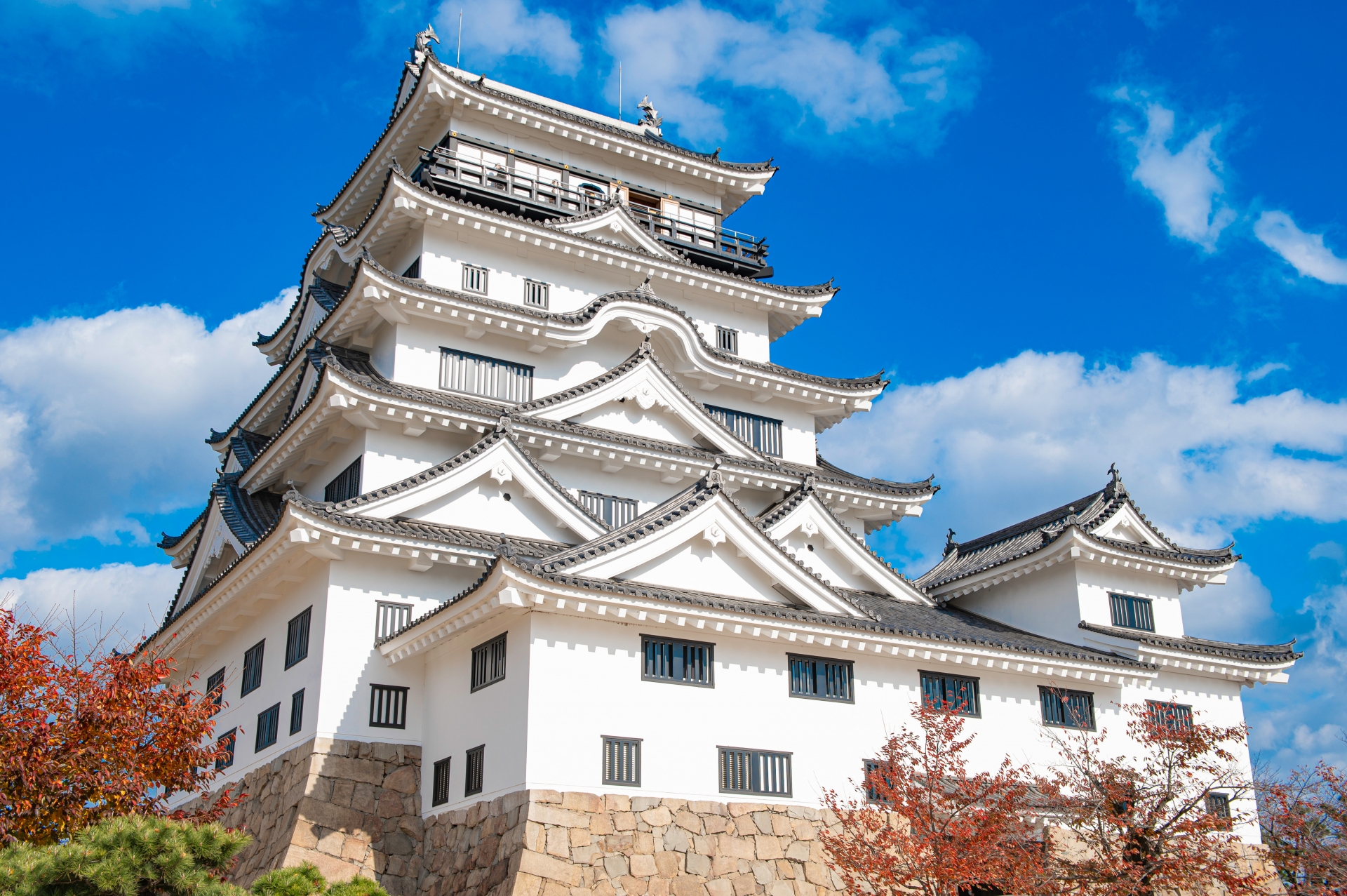
Fukuyama Castle, originally constructed in 1622, stands as a symbol of defense and power in Japan’s western region. Built by Mizuno Katsunari, a samurai lord, this five-story main keep with a smaller annexed keep was strategically positioned for defense, with its northern side facing the Sanyo Road and the southern side overlooking the sea. This location near Tomonoura, a key coastal port, made the castle a crucial center for military and transport purposes.
The original construction, completed in just two years, incorporated a sophisticated layout designed by Katsunari himself. Notably, the castle’s stone walls were built using materials transported from the islands of Setouchi. Despite the era’s restrictions on castle building, Fukuyama Castle was granted special permission, reflecting its importance as a key defensive point in the western territories of Japan.
Notable Features
(1) Tenshu (Main Keep)
The five-tiered main keep was originally adorned with ornate roofing styles such as the *karahafu* and *chidori hafu*, symbolizing the peace and prosperity of the Edo period. Practical features like gun ports and stone windows were also built into the design, ensuring both aesthetic appeal and defensive capabilities. Interestingly, the materials used for the tenshu came from the Tohoku region, renowned for their durability. The northern side of the castle was uniquely reinforced with iron plates, an unprecedented feature in Japanese castle architecture.
(2) Fushimi Yagura (Fushimi Tower)
A highlight of the Fukuyama Castle grounds, this tower was relocated from Fushimi Castle in Kyoto by order of the second Tokugawa shogun, Tokugawa Hidetada. The three-story tower showcases the grandeur of Momoyama-era architecture and retains visible markings that authenticate its origin. It also served as an armory during the Mizuno era, housing weapons and armor used by the castle’s defenders.
(3) Other Key Structures
Visitors can also explore other significant areas within the castle grounds, such as:
- Kane Yagura (Bell Tower)
- Tsukimi Yagura (Moon Viewing Tower)
- Kagami Yagura (Mirror Tower)
- Oyu-den (Bathhouse)
These structures offer glimpses into the daily life and defense systems of the feudal period, each playing a unique role in the history of Fukuyama Castle.
Restoration and Modern Day
After Fukuyama Castle was destroyed during World War II, the current structure was rebuilt in 1966 through the generous contributions of local businesses and citizens. Most recently, from 2020 to 2022, the castle underwent major renovations, including the restoration of its iconic northern iron plates based on historical photographs and research. This careful reconstruction effort reflects the castle’s significance as the only Japanese castle with this unique feature.
Interactive Experiences
In addition to historical exhibits, Fukuyama Castle Museum offers interactive experiences that bring the past to life. One highlight is the “First Spear Race,” where visitors can relive the legendary feats of Mizuno Katsunari during the Summer Siege of Osaka. Another popular attraction is the *Hinawaju* (matchlock gun) experience, where participants can test their marksmanship by shooting at a target 36 meters away, just as the 87-year-old Katsunari once did.
Fukuyama Castle is not just a monument to the past but a living museum that immerses visitors in the rich cultural and military history of Japan.
2. Myōō-in Temple: A National Treasure in Japan|明王院
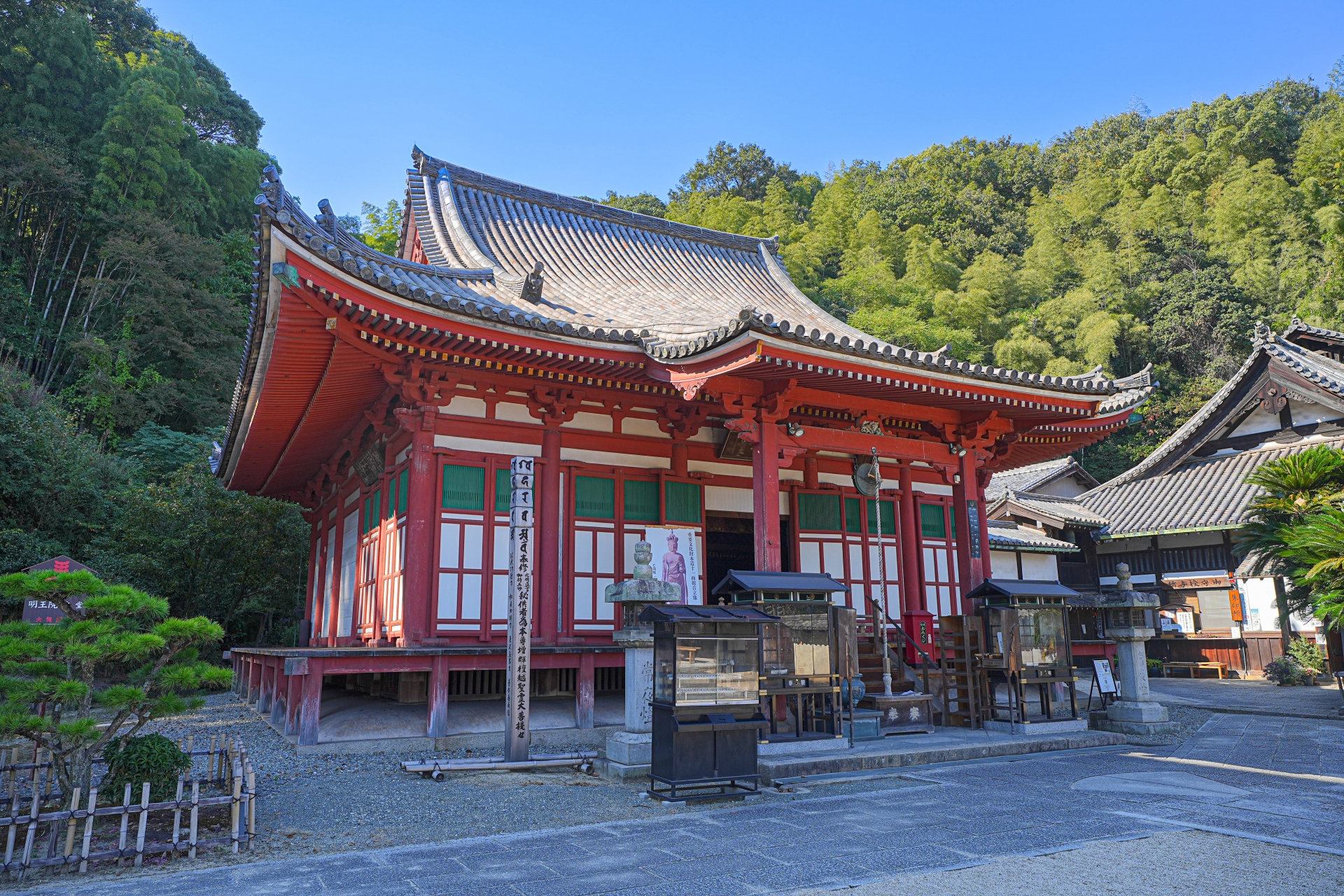
Perched on the slopes of Mount Atago, Myōō-in Temple offers stunning views of the Kusado Sengen-cho ruins and is renowned for its National Treasures: the Main Hall and the Five-Story Pagoda. This ancient temple, affiliated with the Shingon sect of Daikaku-ji, has a long and storied history, dating back to its founding by the legendary Buddhist monk, Kōbō Daishi (Kūkai) in 807. Originally called Saikōzan Rijiin Jōfuku-ji, the temple was renamed Myōō-in after it merged with another local temple in the early Edo period.
A Rich Historical Legacy
Throughout its history, Myōō-in underwent several reconstructions and expansions. In the late Kamakura period, with the flourishing of the Kusado Sengen area, the Main Hall was rebuilt. Later, in the early Muromachi period, the magnificent Five-Story Pagoda was erected, marking Myōō-in as one of the preeminent temples in western Japan during the medieval period.
The temple also played a significant role during the Edo period, receiving the patronage of the Mizuno clan, who ruled over Fukuyama. This support allowed the temple to thrive, and it became the head of a network of 48 subordinate temples, further solidifying its importance in the region.
National Treasures: The Five-Story Pagoda and Main Hall
(1) Five-Story Pagoda
Built in 1348 during the Nanbokuchō period, this pagoda is a rare architectural gem of Japanese history. The pagoda’s central pillar stops at the first floor, an unusual design feature. It stands as one of Japan’s finest examples of *Wayo* (Japanese style) architecture from the Nanbokuchō period, and it ranks as the fifth oldest pagoda in Japan, alongside other esteemed pagodas like those at Horyu-ji and Murō-ji Temples. Inside, the first floor reveals a breathtaking representation of esoteric Buddhist imagery, with vibrant paintings of the Eight Patriarchs of Shingon Buddhism and the 37 deities of the Diamond Realm Mandala, creating a vivid representation of the Pure Land.
(2) Main Hall
The Main Hall, constructed in 1321, represents a fascinating blend of traditional Japanese and Chinese architectural styles, known as *Sekichū Yō*. The hall’s unique ceiling style, called *wagatake*, is extremely rare and showcases the skill and craftsmanship of the era. Together with the Main Hall of Jōdo-ji Temple in nearby Onomichi, it is one of the oldest examples of *Sekichū Yō* architecture in the Seto Inland Sea region.
A Place of Spiritual and Cultural Significance
Myōō-in’s rich spiritual heritage is complemented by its artistic treasures. While many of the temple’s original mandalas and Buddha statues are now housed in the Tokyo National Museum, visitors can still experience the grandeur of the temple’s remaining artifacts and architecture. The combination of breathtaking views, historical significance, and the beauty of Japanese religious art makes Myōō-in a must-visit for any traveler exploring the Fukuyama area.
Whether you are interested in Japan’s rich cultural heritage, Buddhist history, or simply looking for a peaceful place to reflect, Myōō-in Temple offers a deep connection to Japan’s past and a serene atmosphere to enjoy.
3.The Tomonoura Lantern (Jōyatō)|常夜燈
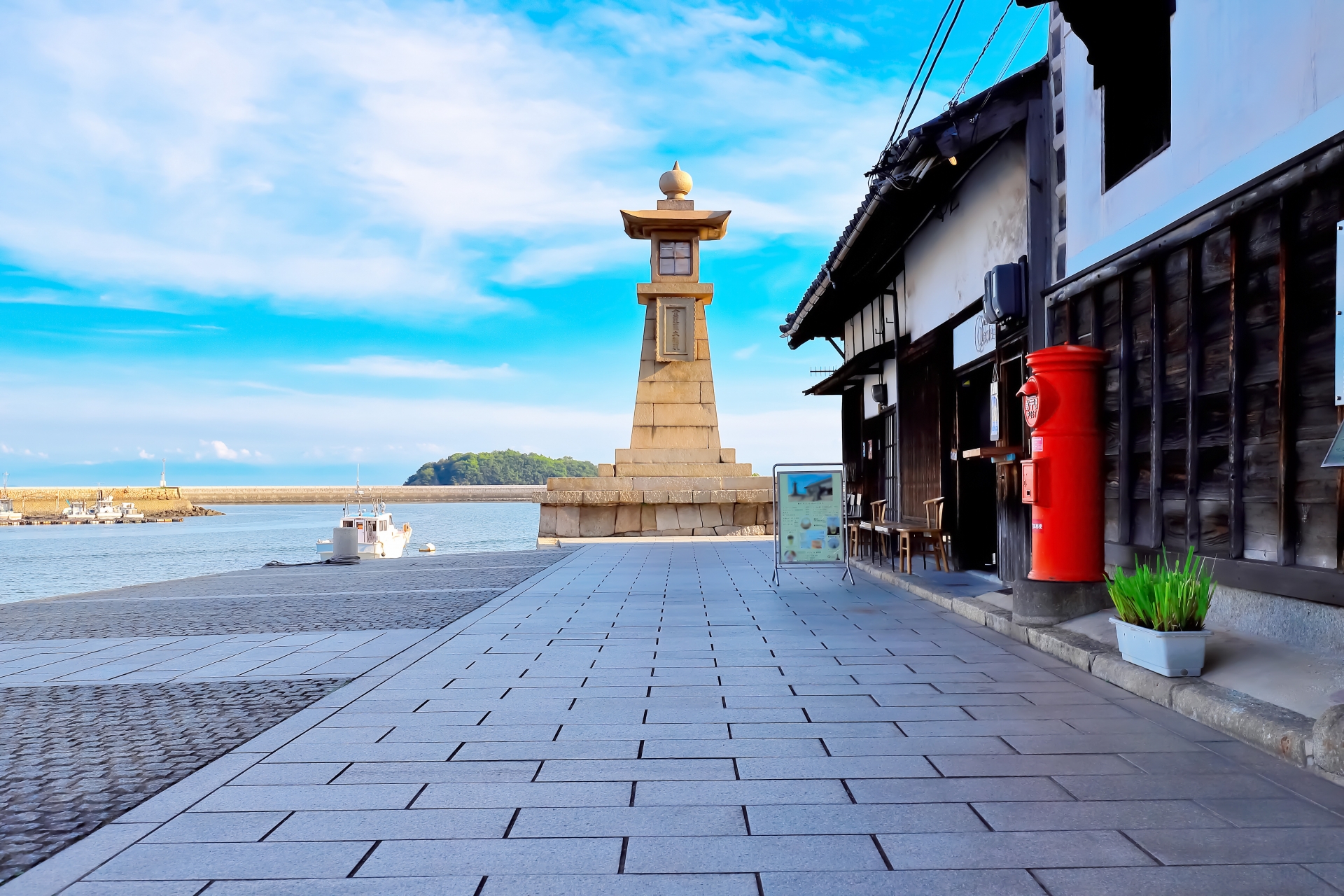
Standing on the western side of Tomonoura Harbor, the Jōyatō Lantern is an iconic symbol of Tomonoura, a picturesque port town in the Seto Inland Sea. Built in 1859, this towering stone lantern guided ships safely in and out of the harbor during the Edo period. With a height of 5.5 meters (11 meters from its base in the water to the top), it is one of the largest surviving Edo-era lighthouse lanterns in Japan.
A Symbol of Tomonoura’s Maritime Heritage
Tomonoura was historically known as a “waiting port” for ships navigating the challenging tides of the Seto Inland Sea, where the Bungo and Kii channels converge. The natural, crescent-shaped harbor provided safe anchorage for ships waiting for favorable tides, making it a bustling maritime hub. The Jōyatō Lantern, along with other features like the *gangi* (stone steps leading down to the water) and the *funabansho* (guard post for ships), tells the story of this thriving port.
A Guide for Safe Passage
The Jōyatō was not just a landmark but a functional lighthouse, providing light to sailors navigating through the dark, treacherous waters at night. Its role in maritime safety is immortalized in stone carvings on its southern side, which bear the name “Konpira Daigongen,” a deity revered for protecting seafarers, and on the northern side with the inscription “Gion Shrine,” further emphasizing its sacred function.
Historical Importance
Tomonoura has been a significant port for centuries, attracting attention even from international visitors. In 1826, the Dutch physician Philipp Franz von Siebold described Tomonoura as a lively town in his travel writings, reflecting its importance in trade and maritime activities.
Remarkably, the Jōyatō Lantern, along with other Edo-period harbor facilities like the *gangi*, wharves, and the remains of the old guardhouse, has survived almost entirely intact. Tomonoura is the only place in Japan where such a complete historical portscape remains.
A Scenic View of the Seto Inland Sea
The Jōyatō Lantern is more than just a relic of the past. It remains a beloved symbol of Tomonoura and contributes to the scenic beauty of the Seto Inland Sea. Visitors can enjoy breathtaking views of the harbor, with the lantern illuminating the waters at night, adding to the town’s nostalgic and romantic atmosphere.
For those interested in Japan’s maritime history or simply seeking a picturesque coastal town to explore, the Jōyatō Lantern and Tomonoura offer a unique glimpse into Japan’s rich cultural heritage and seafaring past.
4.Taichoro Pavilion at Fukuzenji Temple|福禅寺 対潮楼
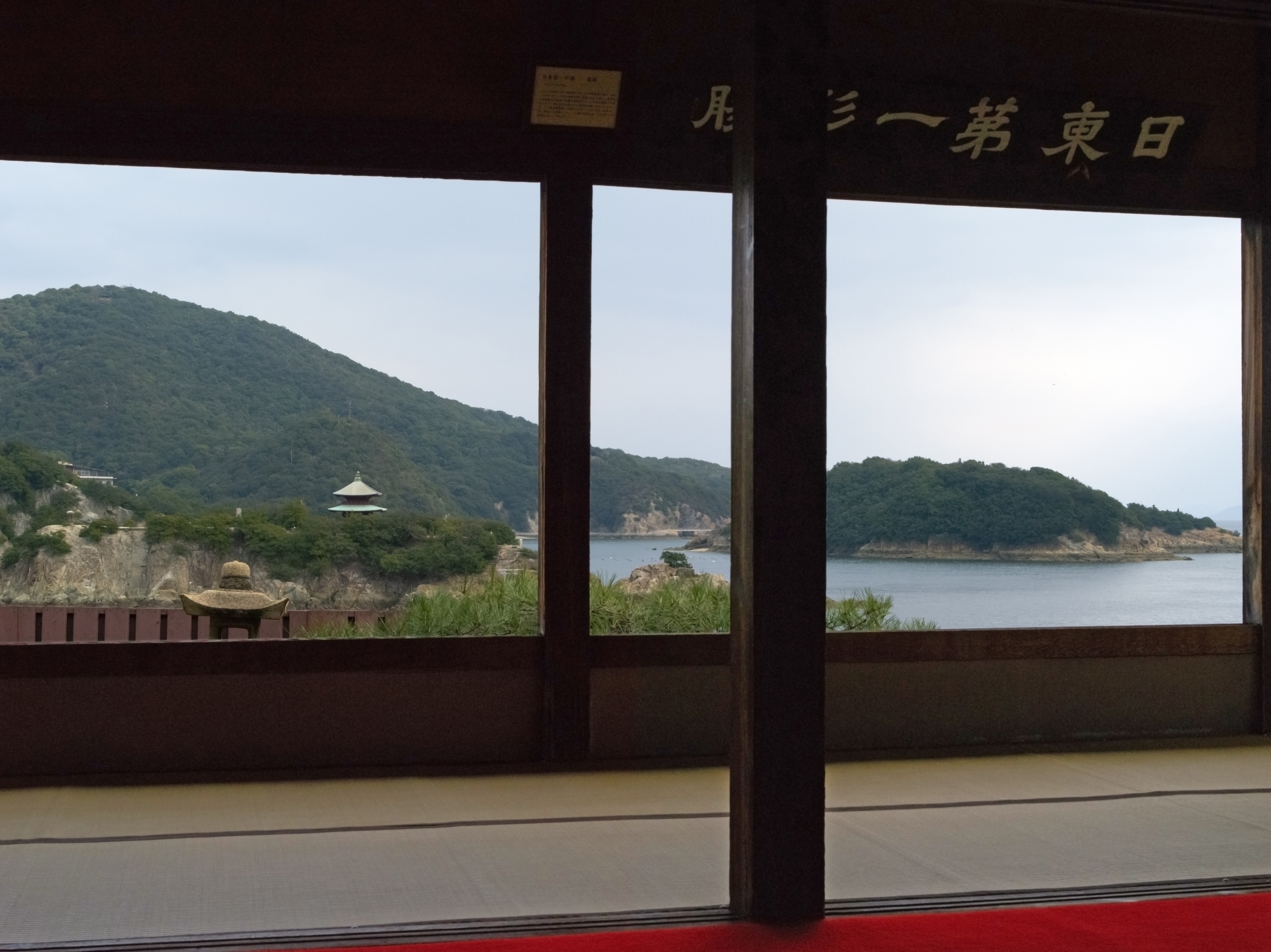
Taichoro Pavilion, part of Fukuzenji Temple, is not only a place of spiritual significance but also a historical landmark. Built around 1690 as a guesthouse for the Shingon Buddhist temple, this pavilion offers breathtaking views of the Seto Inland Sea, with Sensuijima and Bentenjima islands beautifully dotting the tranquil waters.
A Place of Diplomatic and Cultural Exchange
Taichoro is renowned for being the site where a significant historical event took place. In 1867, during the famous “Iroha Maru Incident,” the loyalist group led by Sakamoto Ryoma held negotiations with the Kishu Domain at this very location. This adds to the historical intrigue of the pavilion, making it a must-visit for history enthusiasts.
During the Edo period, Taichoro also served as a reception hall for Korean emissaries, the Tongsinsa, who visited Japan as part of diplomatic missions. In 1711, the Korean envoy Yi Bang-eon famously praised the view from Taichoro as “Nitto Daiichi Keisho,” which means “the most beautiful scenic spot in Japan.” This recognition from an international guest further highlights the pavilion’s significance as a cultural and diplomatic hub.
A View Celebrated for Centuries
The view from Taichoro has captivated visitors for over 300 years. The serene panorama of the Seto Inland Sea remains unchanged since the Edo period, offering visitors a rare opportunity to experience Japan’s historical beauty just as it was admired by people centuries ago. The view from the pavilion has been featured in various modern media, including the opening sequence of the iconic anime “Sazae-san” and the album cover for Shinji Tanimura’s famous song “Ii Hi Tabidachi.”
A National Historic Site
Designated as a national historic site, Taichoro stands adjacent to the main hall of Fukuzenji Temple. The temple itself was founded during the Heian period (947-957) by the monk Kūya Shōnin. Later, in 1638, it became a branch of Daikakuji Temple of the Shingon sect, renamed as Fukuzenji. The pavilion, originally built as a guesthouse, was a venue for intellectual and cultural exchanges during the Edo period, and its beauty and significance continue to draw visitors from around the world.
Taichoro Today
Visitors to Taichoro can still enjoy the spectacular views that earned it such high praise centuries ago. The surrounding area, including the nearby ferry terminal and stone walls, adds to the charm of the location. Whether you are a history buff or simply looking for a serene spot to enjoy the beauty of the Seto Inland Sea, Taichoro Pavilion offers a perfect blend of culture, history, and scenic beauty.
Taichoro is a testament to the enduring allure of Japan’s coastal landscapes and its rich cultural heritage, making it an unmissable stop for any traveler exploring the Tomonoura area.
5.Abuto Kannon (Bandaiji Temple)|阿伏兎観音(磐台寺)
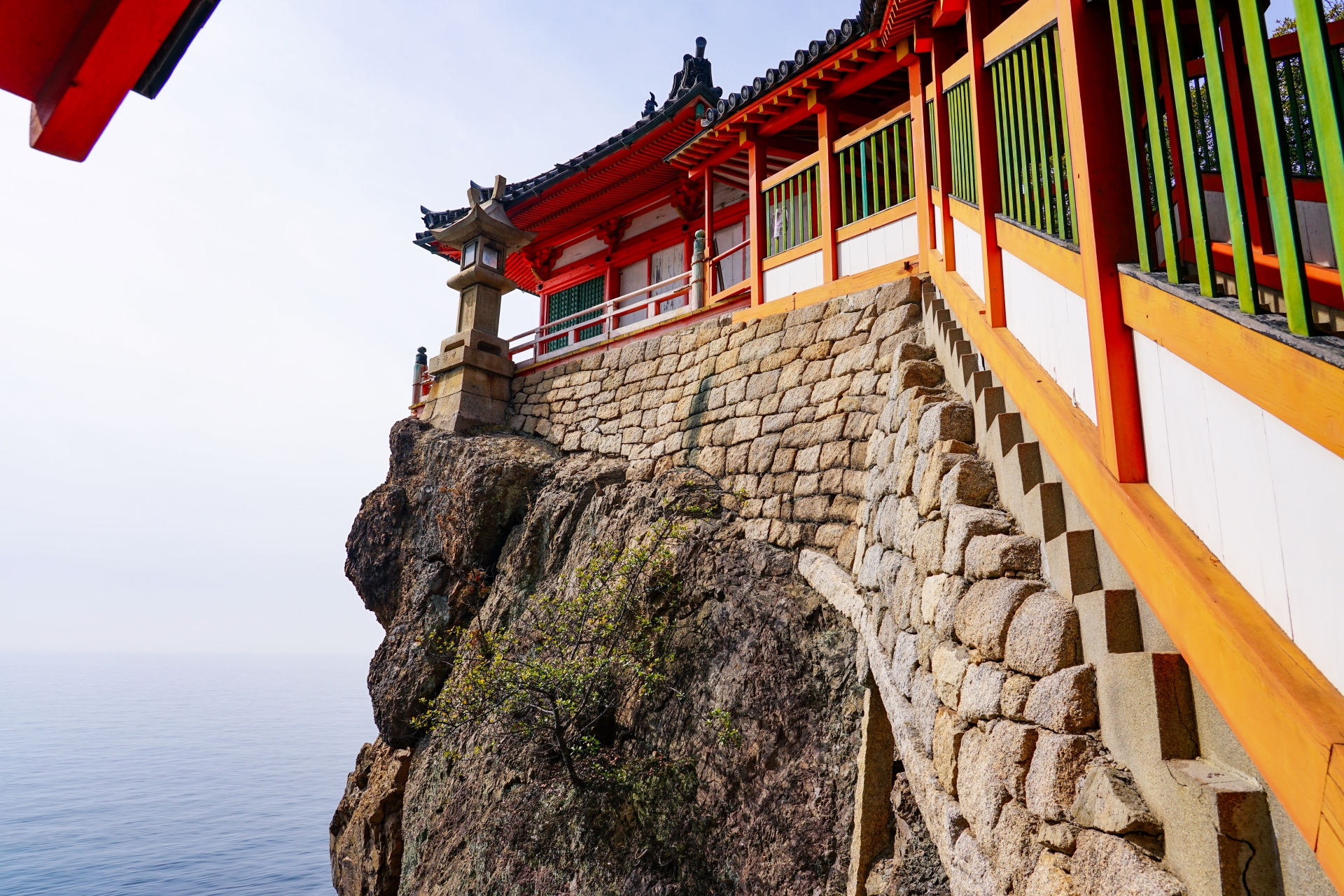
Perched dramatically on the tip of Cape Abuto on the southern end of the Numakuma Peninsula, Abuto Kannon (Bandaiji Temple) is a Zen Buddhist temple of the Rinzai sect. The striking red-lacquered Kannon Hall, built in harmony with the rugged cliffs and clear blue sea, is one of the most breathtaking sights in the Seto Inland Sea. This historic hall, founded by Mōri Terumoto during the Genki era (1570-1573), has been designated as an Important Cultural Property of Japan.
A Place of Prayer for Safe Voyages and Blessings for Children
For centuries, Abuto Kannon has been revered as a place where people pray for safe sea journeys and for blessings related to childbirth and fertility. Inside the Kannon Hall, visitors will find unique “oppai ema” (breast-shaped votive plaques) adorning the walls, offered by women seeking or giving thanks for the blessings of safe childbirth and fertility. The temple’s long-standing role as a place of such prayers adds a spiritual dimension to its natural beauty.
A Stunning View of the Seto Inland Sea
Built on the edge of steep cliffs, the Kannon Hall offers visitors both a sense of thrill and awe. The panoramic view of the Seto Inland Sea from the temple is nothing short of spectacular. The deep blue waters sparkle in the sunlight, and the contrast between the rugged rocky coast and the vibrant red of the hall creates an unforgettable visual experience. The nearby mountains and the glistening sea form a picture-perfect scene, reminiscent of the ukiyo-e prints by famed artist Utagawa Hiroshige, who captured this iconic view in his work.
An Experience of Natural Beauty and History
One of the most striking features of the Kannon Hall is the low railing on the balcony, which only reaches knee-height, giving visitors a thrilling and unobstructed view of the sea below. This, combined with the fresh sea air and the beautiful natural surroundings, leaves a lasting impression on all who visit.
With over 450 years of history, Abuto Kannon has captivated visitors since the Sengoku period. Its stunning views and spiritual significance draw travelers from all over, many of whom return again and again to bask in the serene beauty of the Seto Inland Sea and its surroundings.
Whether you’re seeking a unique cultural experience or simply looking to enjoy the breathtaking scenery, Abuto Kannon offers a memorable visit that connects Japan’s rich history with the natural splendor of the Seto Inland Sea.
6.Fukuyama Auto & Clock Museum|福山自動車時計博物館
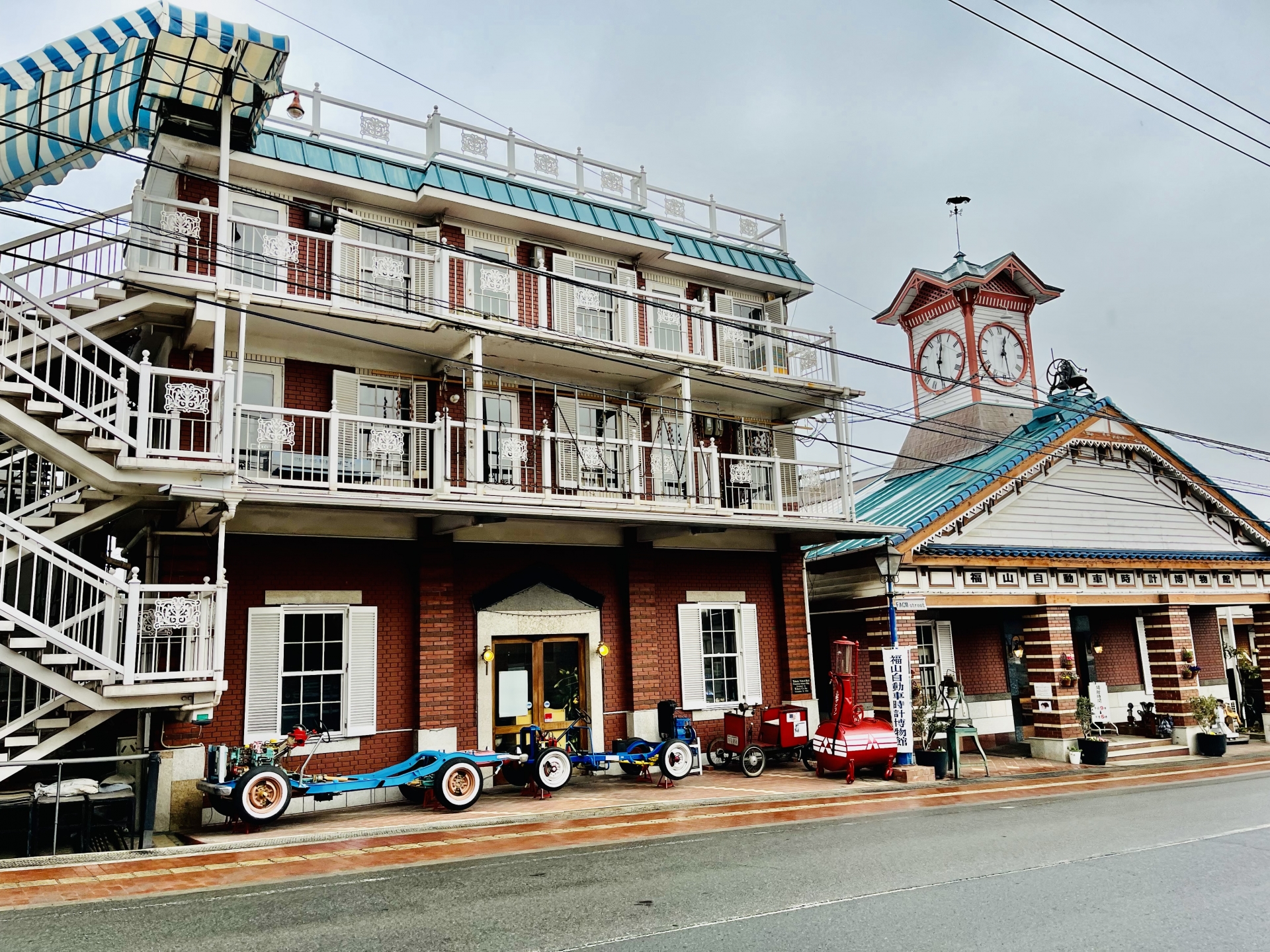
The Fukuyama Auto & Clock Museum offers a unique, interactive experience where visitors can see, touch, and even ride in classic vehicles from Japan and around the world. This hands-on museum is a treasure trove for car lovers, showcasing a wide range of vintage automobiles, including pre-war models like the Ford Model T and Datsun, as well as three-wheeled trucks such as the beloved “Batanko” that were once staples of Japan’s roads. Some of the vehicles on display have even been used in movies and TV dramas.
Classic Cars and More
Inside the museum, you’ll find a stunning collection of domestic and international cars, ranging from classic motorcycles with engine-powered bicycles to the iconic three-wheeled vehicles of the 1930s and 1940s. Larger vehicles like bonnet buses, trucks, and fire engines are displayed outside the museum. Visitors are encouraged to interact with the exhibits—sit behind the wheel, take photos, and immerse yourself in the golden age of motoring.
The museum also features an impressive variety of clocks, from traditional Japanese *wadokei* (Japanese clocks) made during the Edo and Meiji periods to Western-style tower clocks, pocket watches, and table clocks from around the world. This blend of automotive history and horological craftsmanship makes the museum a fascinating destination for history buffs and collectors alike.
Special Events and Group Tours
One of the museum’s most popular attractions is the bonnet bus ride, held four times a year during the spring and summer months. This nostalgic ride allows visitors to experience a piece of Japan’s transportation history firsthand. For groups of 15 or more, private bonnet bus tours can be arranged year-round with a reservation.
With its slogan “Ride it, see it, touch it, take a photo,” the Fukuyama Auto & Clock Museum provides a fun and educational experience for visitors of all ages. Whether you’re a car enthusiast, a history lover, or simply curious about Japan’s mechanical and cultural heritage, this museum offers a unique glimpse into the past.
Plan your visit and enjoy a journey through time, exploring everything from vintage vehicles to intricate clocks that have marked the passage of time for centuries.
7.Shinshoji Zen Museum and Gardens|神勝寺 禅と庭のミュージアム
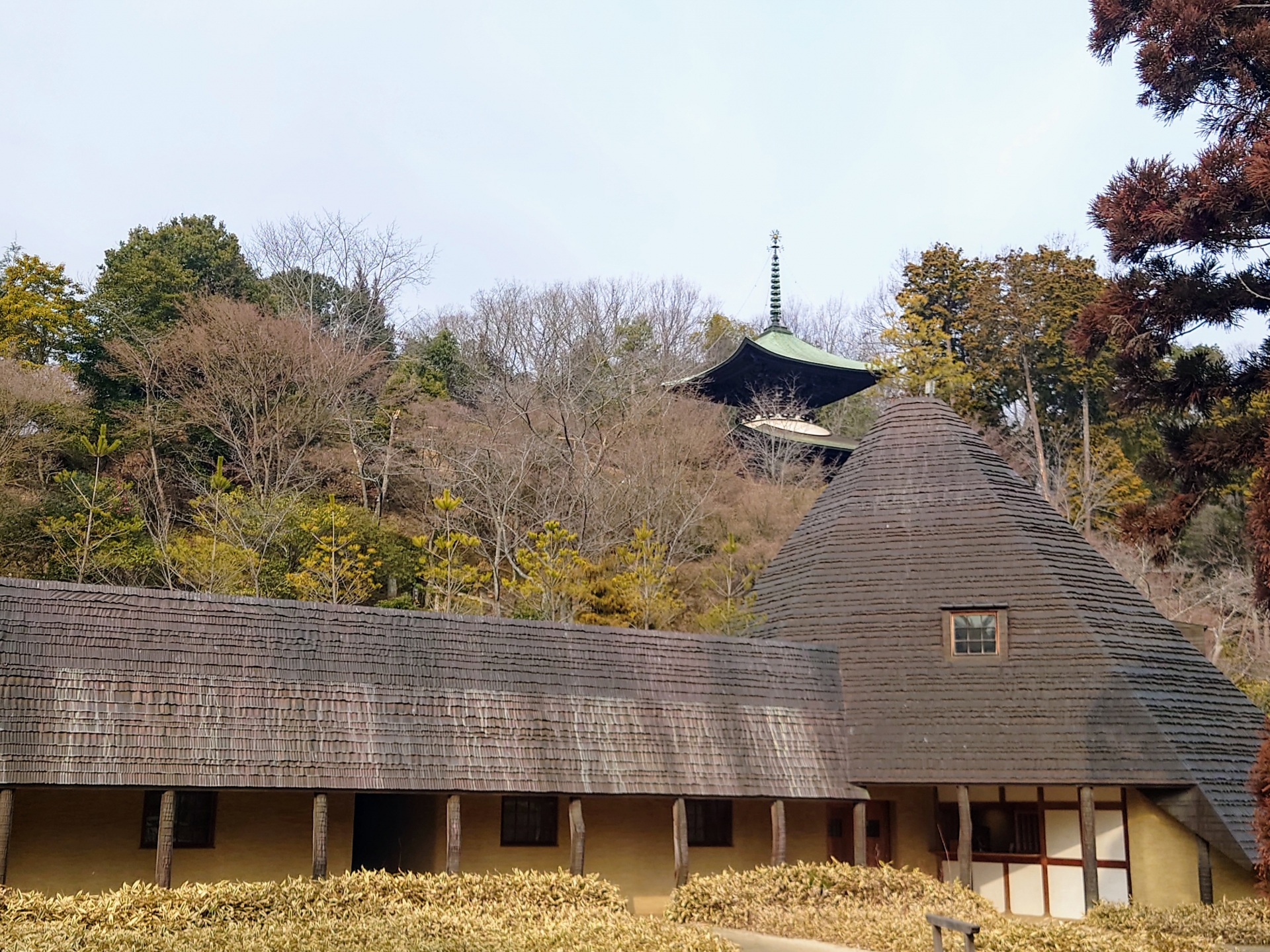
Opened in 2016, Shinshoji Zen Museum and Gardens is a unique facility designed for visitors to experience Zen through art, architecture, and meditation. Located in the peaceful surroundings of Fukuyama, this museum offers a refreshing retreat for both body and mind. The concept of “See. Walk. Rest. Meditate.” invites visitors to immerse themselves in the world of Zen at their own pace.
A Harmony of Zen and Art
The museum’s grounds are home to several architectural and artistic masterpieces, including the *Kohtei* Art Pavilion, designed by renowned sculptor Kohei Nawa and his SANDWICH collective. This boat-shaped structure, made of soft wood, offers a space where light reflects off simulated waves, creating a meditative atmosphere. The pavilion has been featured in prominent magazines such as *Numéro TOKYO* and *Casa BRUTUS*.
Throughout the museum, visitors can view a rotating selection of 20 to 30 Zen calligraphy and paintings from the museum’s collection of 1,500 pieces. These artworks are displayed in various temple buildings without glass cases, allowing for a closer connection to the art and its spiritual meaning. In addition, Shinshoji has revived traditional elements of Japanese culture, including a tea room modeled after Sen no Rikyū’s original design.
Immersive Zen Experiences
At Shinshoji, visitors can do more than simply view art. The museum offers Zen meditation and tea ceremony experiences, allowing guests to engage deeply with Zen philosophy. The international Zen dojo offers both day and overnight meditation retreats, providing a chance to relax, reflect, and practice Zen in an authentic environment.
Guests can also enjoy *Shinshoji Udon*, a dish recognized as a Fukuyama brand specialty, or relax with matcha and traditional Japanese sweets in the serene tea rooms. These culinary offerings are meant to nourish both body and soul, in keeping with Zen traditions.
Historic Buildings and Gardens
The museum grounds include a variety of historic and restored buildings, such as a tea house modeled after Sen no Rikyū’s original design and a Zen garden known as *Shosintei*, created by renowned garden designers Nakane Shiro and Nakane Yoshihiro. The *Kaisando* Hall, modeled after a famous Kamakura-era structure, pays tribute to Shinshoji’s founder, while the *Gokando* Hall offers a taste of monastic life, where visitors can experience a traditional meal served in Zen-style bowls.
Shinshoji also features several iconic architectural elements, such as the *Somon* gate, relocated from an imperial residence, and the *Matsudo* building, designed by architect Terunobu Fujimori to blend seamlessly with the natural landscape using pine trees, copper roofing, and bamboo fencing.
A Destination for Reflection and Renewal
Shinshoji Zen Museum and Gardens provides a rare opportunity to experience the beauty and tranquility of Zen in a setting that combines art, history, and nature. Whether visitors come for the meditation, the art, or simply the serene gardens, they are sure to leave feeling refreshed and inspired.
For those looking for an immersive Zen experience, Shinshoji offers a range of activities, from seated meditation (*zazen*) to calligraphy practice (*shakyo*), making it an ideal destination for anyone seeking peace and mindfulness in the modern world.
As you explore Fukuyama’s historical landmarks, vibrant culture, and serene landscapes, you’ll discover a city that seamlessly blends the old and the new. From the grandeur of Fukuyama Castle to the peaceful tranquility of Shinshoji Zen Museum and Gardens, each destination offers a unique window into Japan’s rich heritage. Whether you’re captivated by the timeless beauty of the Seto Inland Sea or drawn to the intricate craftsmanship of vintage clocks and classic automobiles, Fukuyama promises unforgettable experiences for every traveler. As you leave, you’ll carry with you memories of a city where tradition and innovation thrive side by side—inviting you to return and explore even more.



